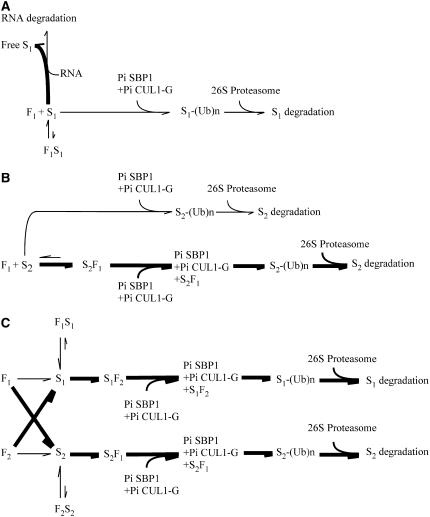Figure 9.
Model for the Biochemical Mechanism of S-Specific Inhibition of Pollen Tube Growth.
F1 and F2 indicate Pi SLF1 and Pi SLF2, respectively; S1 and S2 indicate S1-RNase and S2-RNase, respectively; S1-(Ub)n and S2-(Ub)n indicate S1-RNase and S2-RNase conjugated with ubiquitins, respectively. The interactions between a Pi SLF and its self and nonself S-RNases are depicted differently (e.g., F1S1 for self interaction and S2F1 for nonself interaction) to emphasize that self and nonself interactions likely involve different domains of both Pi SLF and S-RNase. Thick lines denote the predominant reactions.
(A) Incompatible pollination. Pi SLF1 produced in the S1 pollen tube interacts weakly with its self S-RNase, S1-RNase, and thus most of the S1-RNase molecules taken up by the pollen tube and located in the cytoplasm are free to degrade RNA. The small amount of S1-RNase molecules that interact with Pi SLF1 are not degraded via the S-specific degradation mechanism. Some degradation of S1-RNase occurs via the non–S-specific degradation machinery mediated by Pi CUL-G-Pi SBP1; this could account for the basal degradation of S1-RNase observed in our in vitro system.
(B) Compatible pollination. Pi SLF1 interacts strongly with its nonself S-RNase, S2-RNase, and the interaction results in the degradation of S2-RNase via the S-specific degradation mechanism mediated by the E3 ligase complex containing Pi SBP1, Pi CUL1-G, and Pi SLF1. Thus, most of the S2-RNase molecules taken up by the pollen tube and located in the cytoplasm are ubiquitinated and degraded. A small number of S2-RNase molecules that do not interact with Pi SLF1 are degraded by the non–S-specific mechanism, as in incompatible pollination (A).
(C) Competitive interaction. When Pi SLF1 and Pi SLF2 are produced in the same pollen tube, Pi SLF1 preferentially interacts with S2-RNase and Pi SLF2 preferentially interacts with S1-RNase. Thus, other than having two Pi SLFs and two S-RNases in the same pollen tube, the scenarios described for (B) apply here. For simplicity, the basal degradation pathways, as shown in (A) and (B), are not depicted.

